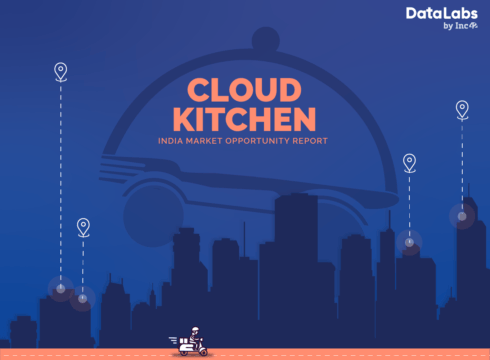DataLabs By Inc42 estimates cloud kitchen to have a projected market size of $1.05 Bn by 2023 on the back of rising disposable income and changing consumer mindset
With easy access to discounts and apps, 60% of millennials order food or dine out at least once a month
But are cloud kitchens too dependent on aggregators and will this dent their margins in the long run?
Inc42 Daily Brief
Stay Ahead With Daily News & Analysis on India’s Tech & Startup Economy
Over the past decade, India has grown rapidly to become more urbanised, more connected and everyday life is increasingly driven by tech services and products.
As the per capita income of the Indians has swelled (10% in FY19), there are more working people in a household now. Both male and female members of the family are now involved in full-time jobs, and the outlook towards home cooking is slowly changing. With busy schedules, near-constant work pressure, ordering-in has become the easiest solution to hunger.
According to an analysis by Deloitte, convenience is an important consideration for millennials on account of their hectic lifestyle. Lack of time is one of the key reasons for growth in online shopping and online ordering from restaurants. Millennials are eating out or ordering food more frequently compared to Gen-Xers, who are now in their late 30s and 40s, and ‘Baby Boomers’, who are close to the age of retirement. Over 60% of millennials order food in or dine out at least once or more than once a month.
Riding on the increased purchase power and high demand, the Indian online food delivery market (aggregators and cloud kitchen) is expected to be an over $5 Bn opportunity by the end of the year 2023. As per DataLabs estimates, the projected market size of cloud kitchens is expected to reach $1.05 Bn by 2023.
While the projected market size showcases huge opportunity, it is only fair to look if the associated factors that would be driving the market are favourable to its growth. A detailed analysis of favourable and unfavourable factors driving the cloud kitchen market has been done in our recently released report “Cloud Kitchen: India Market Opportunity Report 2019” with DineOut as an associate partner.
Brand association and brand recall are key drivers of growth for any FMCG company and the same applies to cloud kitchens as well. A study shows while price, taste and convenience are traditional drivers for consumers, they are also increasingly looking for healthier options or aspirational tastes.
Cloud kitchens are dependent on platforms such as Swiggy and Zomato for delivery, awareness, reach and customer experience. The major operational costs such as marketing, discoverability and delivery are being borne by these platforms. This is not necessarily a good thing, as it increases the dependency of cloud kitchens on aggregator platforms.
While wider audience reach and last-mile fulfilment are great, the cloud kitchen suffers from having no meaningful customer interactions and this impacts customer retention in cloud kitchens. Cloud kitchens are unable to use their brand and vision to build a loyal customer base, despite being a popular option for new-age customers in India.
Then there’s the problem of long-term margins. Thanks to the reduced operational cost, cloud kitchens as a business model seem more viable than restaurants, especially given the huge growth in online ordering. However, platforms such as Zomato and Swiggy are not even operationally break even. For aggregator businesses, the cost of servicing the restaurants and cloud kitchens needs to keep rising to meet break-even levels. And once the platform cost goes up, cloud kitchens will see reduced margins in the future.
Lastly, Zomato and Swiggy have also entered the cloud kitchen market. By creating an infrastructure that new cloud kitchens can use, aggregator platforms are creating new competition for existing cloud kitchens listed on their platforms.
The low setup cost, lower operational expenditure and rising appeal for home delivery have made the Indian cloud kitchen market very crowded indeed. Customer acquisitions are driven by discounting and offers largely, which means there’s a high acquisition cost. This model of driving sales through discount will eventually bite into profitability in the longer run.
To get detailed analysis and projections for cloud kitchen market check out “Cloud Kitchen: India Market Opportunity Report 2019” report released by DataLabs.
DOWNLOAD THE FULL REPORT
{{#name}}{{name}}{{/name}}{{^name}}-{{/name}}
{{#description}}{{description}}...{{/description}}{{^description}}-{{/description}}
Note: We at Inc42 take our ethics very seriously. More information about it can be found here.


